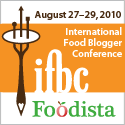First, I have to say that I'm one of those people who goes totally dumbmus over hummus.
It's something I can eat everyday with just about anything - vegetables, breads, meats, soups, salads, even by itself!
So whenever I get a chance to have some really good hummus, as you have to choose wisely as they aren't all made the same, I am always in for a savory treat.
Since I've been on a detox eating plan for the past week, I've been trying out all sorts of recipes and adding them into my culinary book of shadows. One of those random ideas popped into mind while I was munching on some lightly salted and warm edamame for a protein snack. I decided to not only make my own hummus at home for the first time, but to take my love for edamame and make...wait for it...
Edamame hummus! *cue in falling balloons and exploding confetti*
Hummus is traditionally made with chickpeas (or garbanzo) beans. But you can make hummus from some other legumes. Even lentils and red beans! Get as creative as you want with legume substitutions. They each will make for a distinctive-tasting, differently-colored hummus.
 |
| Living Tree Community Foods Tahini |
For example, you can make a tahini-based hummus, a roasted garlic-based hummus, a cilantro/parsley-based hummus, a spicy hummus (roasted peppers or lots of cayenne), a yogurt-based hummus or a hummus that uses butter rather than olive oil. I've had many varieties of hummus and like them all, but I tend to prefer hummus with a good roasted garlic and tahini taste. I also love the flavor of olive oil (premium extra virgin olive oil). Additionally, you can substitute toasted sesame oil for tahini.
Edamame, which is a dish or snack of young soybeans encapsulated in pods (similar to pea pods) are a wonderful replacement for chickpeas in hummus. They are naturally rich and buttery in flavor, a great source of protein, and extremely healthy. You'll often see them served in Japanese restaurants, as an appetizer or entrée, with miso soup before a main course.
I pretty much winged this recipe based on what a traditional tahini has and according to my personal tastes.
 |
| Organic, shelled edamame |
I made a note of all of the ingredients going into my edamame hummus aside from the obvious (the edamame soybeans):
- Tahini (between 1/8 - 1/4 cup; it's up to you, taste as you go)
- Water (loosely 1/4 cup)
- Lemon juice (1 lemon's worth)
- Olive oil (3-4 tablespoons)
- Cumin seeds (1 teaspoon)
- Green onions (1/4 cup; I really like onions)
- Cayenne pepper (a dash to sprinkle on top when the hummus is done)
- Black sesame seeds (sprinkled liberally on top when the hummus is done)
- Parsley (Italian) (1.5 tablespoons; you can also use cilantro)
- Garam masala (half teaspoon)
- Fennel seeds (1 teaspoon; I highly enjoy the flavor of these)
- Sea salt (to taste)
- Garlic (2-4 cloves; or to your taste)
 |
| Several of the ingredients I used in my hummus |
Start off by pouring in 3 to 3.5 cups of water in a medium pot. Bring the water to a boil.
 |
| Drained edamame soybeans |
Take them off the stove and drain the water out.
 |
| Ready to process |
Pulse and blend until the mixture is very smooth. You can choose to have a more rustic edamame (textural) if you want, but I prefer it relatively smooth.
 |
| Smooth edamame hummus |
Take some vegetables of your choice (I chose organic baby carrots, celery, and red bell pepper) and cut and slice them up as necessary so that you can dip these into the hummus for a complete snack. I left the baby carrots as is, I deseeded and cut the red bell peppers into strips, and I cut and neatly sectioned the celery into small sticks.
I unplugged my food processor and poured and scraped out my hummus into a bowl and swirled it around to my liking. Then I drizzled in some more extra virgin olive oil into the crevices of the dip and sprinkled in my cayenne pepper, black sesame seeds, and a small pinch more of sea salt.
You can even add sprouted seeds (which I just discovered and am now immensely enjoying). Sprouted sesame seeds are absolutely yummy and go well on top of hummus, among many other things...
This dish made for a hearty lunch, and my adventure in making hummus at home was a successful and enjoyable one. I've since prepared this several more times and have experimented with other herbs and spices. I'd love to try red or black lentils next time!
What is your favorite kind of hummus? And what do you like in your hummus?






















